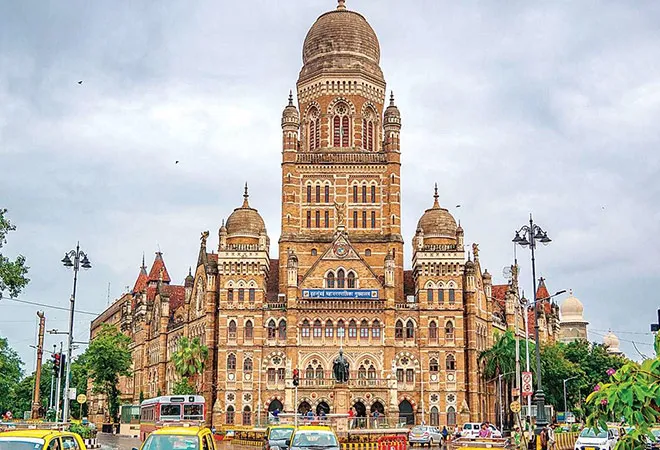-
CENTRES
Progammes & Centres
Location

Innovative initiatives need to be taken to diversify BMCs revenue handles The financial health of the Brihanmumbai Municipal Corporation (BMC), India’s richest civic body, is critical. It has financial obligations of INR 1,24,129.28 crores towards the ongoing or planned long-term infrastructure projects but has less than half this money in its reserves. Of its INR 88,304 crores reserve funds, BMC can use only INR 51,147 crores for capital works, as the rest is linked to administrative liabilities. If the BMC is not prudent about its financial planning, commitments, such as the Mumbai Coastal Road Project, Sewage Treatment Plants (STPs), waste-to-energy plant, the Goregaon Mulund Link Road (GMLR) with a tunnel under Sanjay Gandhi National Park (SGNP), and over 30 other projects in the pipeline can deplete its wealth quickly.
BMC has somehow managed to balance its books with compensation from the state government in lieu of Octroi—it applies to goods brought into the local area, but not to goods produced within the local area.
BMC’s financial health reflects the larger malaise impacting Urban Local Bodies (ULBs) across India after Octroi—the largest own-source of revenue ULBs that ensured their fiscal autonomy—was subsumed by the Goods and Services Tax (GST) in 2017. BMC, like most other ULBs in the country, is yet to establish an alternate source of revenue to match income from Octroi. BMC has somehow managed to balance its books with compensation from the state government in lieu of Octroi—it applies to goods brought into the local area, but not to goods produced within the local area. However, it has also expressed the need not to be over-reliant on it, as the annual compensation, promised at an increasing rate, has remained short of the civic body’s budget estimates. Consequently, since 2020, it has borrowed internally to meet its fiscal demands and also dipped into its reserves to finance the ongoing and proposed mega infrastructure projects. For 2023-24, BMC budgeted INR 52,619.06 crore. It expects compensation for Octroi to contribute 39.5 percent of the corporation’s estimated income of INR 33,290.03 crores. With Octroi gone, property tax is its largest revenue source, contributing 18 percent to the year’s estimated income, followed by premiums from real estate, contributing 13 percent. BMC withdrew INR 12,776 crore from its reserves for planned projects and borrowed INR 5,970 crore through internal loans.
In each budget since 2017, BMC has acknowledged having limited financial resources, the need to augment revenue sources and to spend its money wisely. However, it has committed to measures of fiscal discipline half-heartedly. It lacks the political backing required to take difficult decisions that will cost more to the taxpayer and the capacity-building mechanisms to fix shortcomings of the existing systems. Multiple initiatives over the past few years to enhance revenue collection have yet to materialise.
In 2016-17, BMC requested the Maharashtra government to grant powers to levy and collect professional tax, which is collected by the state government. It also requested an amendment to the Maharashtra Stamp Act, 1958, to introduce a surcharge of 1 percent of the value of the immovable property on all deals. The surcharge would earn BMC an additional revenue of INR 3,000 crore but would make escalate real estate prices. Both suggestions did not materialise—the former because of the reluctance of the state to devolve its powers to levy tax, and the latter because of its political sensitiveness.
Regularisation of unauthorised construction on leased plots in a breach of the lease would earn the civic body INR 30 crore annually, but it needs to be streamlined and done on time.
The revision of property tax, due in 2020, was deferred due to the COVID-19 pandemic. Despite causing a loss of INR 1,080 crore to the BMC, the decision is still awaiting clearance from the state government. To make matters worse, the Maharashtra government’s populist decision to exempt properties under 500 sq. ft. from property tax led to an annual loss of revenue amounting to INR 462 crore, with 1,614,000 citizens exempted from paying property tax.
Delay in the renewal of the leases of municipal plots has further dented civic revenues. Regularisation of unauthorised construction on leased plots in a breach of the lease would earn the civic body INR 30 crore annually, but it needs to be streamlined and done on time. In 2019, BMC came up with its Vacant Land Tenancy policy, applicable to over 200 plots leased by the civic body decades ago at a nominal annual rent. Under this policy, BMC planned to lease them for 30 years at a one-time premium of 62 percent of the ready reckoner rate and expected an income of INR 500 crore annually. In 2022, BMC relaxed the policy due to poor response.
Experts and top bureaucrats emphasise the need for ULBs to reform their perspective. Although providing services is the main priority, ULBs need to consider revenue generation as one of the targets for effective governance. This must be done in moderation and with transparency, where the money earned could be invested into infrastructure and amenities. Money invested in infrastructure circles back to municipal coffers, as infrastructure can create new catchment areas of spiked real estate prices and higher premiums. However, rampant taxation would place an unfair financial burden on the citizens. Finding new revenue sources for dynamic cities such as Mumbai can be relatively easy. BMC can consider setting up a dedicated department or preparing project-specific models of revenue generation to cover functional costs.
Money invested in infrastructure circles back to municipal coffers, as infrastructure can create new catchment areas of spiked real estate prices and higher premiums.
In 2019, the erstwhile Shiv Sena-led BMC, in yet another populist gesture, announced that its INR 12,696 crore coastal road would be toll-free. Considering the initial estimates that 343,126 vehicles will use the coastal road in 2024, even a nominal toll fee could have generated substantial revenue. The toll can be a useful fiscal instrument to moderate traffic and control the overall volume of vehicles on the streets. Allowing free movement of vehicles on such capital-intensive civic infrastructure runs the risk of diverting the entire traffic from arterial roads to coastal roads. This would merely transfer the congestion from the existing routes to the new coastal transitway. The Bandra Worli Sea Link witnessed heavy traffic jams when it was declared toll-free for a short period in 2016. The BMC must also consider imposing tolls for vehicles using the GMLR.
Aligning policy goals with revenue generation in the case of Mumbai can fast-track the implementation of both. Measures such as hiking on-street parking fees and imposing stiff and exponential fines for illegal parking can serve the dual purpose of disciplining traffic by streamlining parking, providing an equitable distribution of public spaces and reducing congestion while creating an additional revenue source.
As a megacity, Mumbai has the advantage of opting for innovative revenue models such as curating tourism packages to showcase its municipal machinery and historical and natural heritage; renting out classrooms in municipal schools for private tuitions after school hours; renting open spaces attached to municipal offices for professional purposes such as education or employment fairs or symposiums; and renting facades of municipal market buildings for advertisements, with riders to maintain the sanctity of public property.
Speaking to this author, a former bureaucrat pointed out, “Municipal properties are public assets, and we lack the mindset of making money from such assets. Innovative revenue options have not been tried simply because BMC has not yet faced an inevitable need to do so. However, necessity is the driving force for innovation.”
Mumbai has the advantage of opting for innovative revenue models such as curating tourism packages to showcase its municipal machinery and historical and natural heritage
The challenges are complex and multifaceted. BMC’s attempts in the past to raise funds through municipal bonds were opposed by elected representatives citing under-preparedness. The Fee Revision Authority proposed in 2021 to recalibrate all municipal fees and taxes, or the Mumbai Parking Authority to act as the apex body to regulate parking in the city, are yet to materialise.
Administrative planning is “municipal commissioner-centric” rather than “policy-centric”. An analysis of municipal budgets in the past decade reveals a concerning trend: proposed plans are often abandoned when a new commissioner assumes office, highlighting the need for a steadfast commitment to execute long-term visions of the civic body. BMC is often hailed as India’s most efficient city authority. It is high time the state loosens its financial control over civic matters, and the political class recognises the importance of economic prudence over populism. Innovative initiatives to diversify BMCs revenue handles can set a template for other ULBs across India.
Eeshanpriya M.S. is a writer and journalist with over eight years of experience reporting extensively on governance and administration in Mumbai and Maharashtra, focusing on civic issues affecting India's commercial capital.
The views expressed above belong to the author(s). ORF research and analyses now available on Telegram! Click here to access our curated content — blogs, longforms and interviews.

Eeshanpriya M.S. is a writer and journalist with over eight years of experience reporting extensively on governance and administration in Mumbai and Maharashtra focusing on ...
Read More +